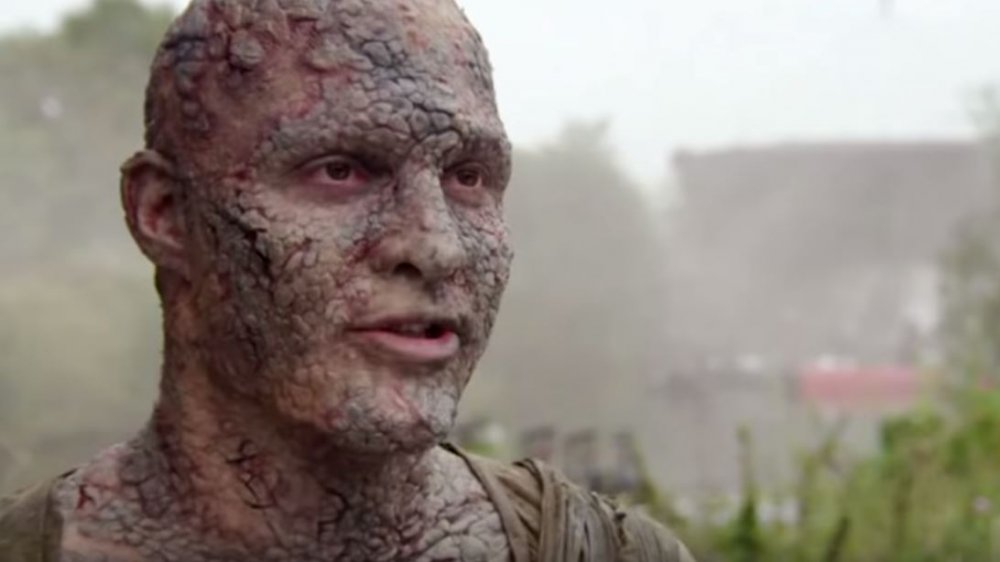The Craziest Fictional Diseases From Movies And TV
Widespread disease is everybody's least favorite apocalypse scenario. Seriously. Sure, it's not great if aliens zoom down from the sky with death rays, and equally scary when everybody's driving around a post-nuclear landscape in jacked up vehicles and cool costumes ... but at least those scenarios lead to massive gatherings, with some grizzled hero giving a triumphant speech to the crowds. Disease apocalypses, on the other hand? Nah, forget crowds — that's what caused this issue in the first place!
In real life, of course, the symptoms of most mass illnesses tend to be rather similar, whether they're gastrointestinal in nature, or more on the upper respiratory side of things. Not so in fiction, where imagination is the limit, leading to superbugs that can do anything from disrupt the space/time continuum to make people give birth to dinosaurs (more on that later). No wonder some of the most popular movies and television programs have disturbed viewers with an array of insane, transformative diseases that would give anyone the jitters.
When in Westeros, avoid Greyscale like the plague
The world depicted in George R. R. Martin's A Song of Ice and Fire books, adapted into the hit HBO series Game of Thrones, is chock full of scary, ugly, and disturbing things, from wrongful beheadings to murderous weddings. In this land of dark magic and deception, though, one of the most disturbing ailments is greyscale, a highly infectious disease that slowly turns a person's skin hard, cracked, and stone-like. Just the slightest touch from someone's infected skin will rub off, as explained by Vox, meaning that all patients must be strictly quarantined to prevent a greyscale pandemic. To make matters worse, the maesters believe that while a person can live with greyscale for a few decades, it'll only take around six months for the infection to creep into a person's mind, rendering them psychotic.
So, if you're creeping around Essos and catch this horrifying ailment on, say, your arm, what's a person to do? Immediate treatment from the right doc seems to have some effect, as seen with Shireen Baratheon, who managed to get away with only half her face being damaged. The standard treatment, on the other hand, is The Walking Dead approach of just severing the infected area. Ugh. That said, as Bustle points out, the bright and brilliant Samwell Tarly did eventually figure out a way to completely cure this "incurable" disease, to the relief of every germaphobe in Westeros.
The Rage Virus turns people into living 'zombies'
The gritty 2002 horror flick 28 Days Later, starring Cillian Murphy and Naomie Harris, often gets praised as one of the all-time great zombie apocalypse flicks. And, to be fair, it is one of the best. For sure. Except, well, there's not really any "zombies" in it. As die hard fans are now tumbling over one another to point out, 28 Days Later actually depicts the gory results of a so-called "Rage Virus": This contagion infects living humans instead of dead ones, as explained by National Geographic, is derived from Ebola, and has often been compared to sci-fi version of rabies. The virus is transmitted through either saliva or blood, and once a person becomes infected, as explained by Screen Rant, their conscious brain is overwhelmed by the mindless, bloodthirsty urge to commit violence and devastation ... accompanied by hemorrhaged capillaries, for requisite horror movie effect, which cause these poor individuals bleed from their eyes, nose, and mouth.
Where did such a nightmarish disease come from? A lab, of course. The first sequence of 28 Days Later depicts a group of well-intentioned activists breaking experimented chimpanzees out of a lab, and accidentally getting infected as a result. Lest you think humankind would get this kind of thing under control, well, don't forget that there's a sequel, titled 28 Weeks Later ...
Chrono-Displacement Disorder seems a tad ... inconvenient
Time travel simply doesn't make sense. Such is the nature of the beast. Whether you try to explain it by shrinking down into the quantum realm, or hitting the gas on a groovy DeLorean, you'll be dealing with paradoxes and phony science jargon. So hey, why not say it's caused by a disease?
Enter The Time Traveler's Wife, a novel by Audrey Niffenegger which was adapted into the 2009 Rachel McAdams/Eric Bana film of the same name, and depicts the heartbreaking relationship between an ordinary woman and her husband, Henry. This fellow, as explained by SyFy, suffers from a rare condition known as Chrono-Displacement Disorder, which causes him to unwillingly travel through the past or future, though not sequentially, leading to such incidents as him disappearing at a time of great stress, or his adult self meeting his future wife when she's still a young girl. This obviously fictional condition, according to the Washington Post, leaves the poor guy stranded and naked in random times, leaving a pile of clothes behind him — kind of like a time-hopping Bruce Banner, who you might remember Bana also playing back in 2003 — and thereby making the most unimaginably epic relationship challenge for a timeless (sorry) love story.
In the future, HBO plans to adapt this tale once again, as a TV series.
That time the Enterprise faced an outbreak of Barclay's Protomorphosis Syndrome
When you're living in the 24th century, in a timeline wherein interplanetary alliances are a thing, utopian ideals are something everybody strives for, and a cup of coffee comes from the same machine that makes your boots, you can't expect the human race to still be bothered by any of the old-school, Earthly diseases of the 20th and/or 21st century. Nah, those were cured centuries ago. Unfortunately, humankind's desire to propel themselves through space does result in people getting infected with freaky galactic diseases, instead. Yuck.
For example? Take Barclay's Proto-Morphosis Syndrome, AKA the intron virus, as depicted by Star Trek: The Next Generation. This disease, according to StarTrek.com, was named after its progenitor, the Enterprise NCC-1701-D's Lieutenant Reginald Barclay, and is the result of Dr. Beverly Crusher using synthetic T-cells to treat an infection. The symptoms? Well, according to Memory Alpha, it starts with ordinary ol' things like anxiety, fever, and chills, and then causes those who are infected to ... uh, "de-evolve," meaning that crew members physically transform into earlier life forms from their respective home worlds, including early primates, jellyfish, lizards, an amphibious human, and a spidery arachnid creature.
Thankfully, yes, they do find a cure. After all, this is Star Trek, not Alien.
Captain Trips, the Stephen King disease that wiped out humanity
Many fictional diseases are wild, wacky afflictions that seem about as realistic as your average Fast and Furious flick. On the other hand, leave it to Stephen King to come up with something altogether more horrifying. While King's novel The Stand — later adapted into a cult classic nineties TV miniseries starring Gary Sinise, Ossie Davis, and Molly Ringwald — is most remembered for being a truly biblical showdown between the forces of good and evil, the whole shebang launches with a disease outbreak that, at the very least, feels frighteningly real. The disease in question is Captain Trips, aka the Blue virus and/or tube neck, and as SyFy points out, it leads to the decimation of 99 percent of Earth's population. Of course, it doesn't start that way: Originally developed as a biological weapon, Captain Trips initially manifests as nothing worse a common cold, before it mutates to survive any medicines or interventions used against it, and ends with delirium, crippling body aches, and death ... unless, that is, you're one of the very few humans who is immune.
While 1994's The Stand series has its fans, it won't be the last time Captain Trips rears its menacing head, as the book is set for a new television adaptation from Josh Boone, according to Den of Geek.
That Boneitis sure gets you fast
Futurama fans might remember "That Guy," AKA Steve Castle, the slick businessman from the eighties who, as Buzzfeed points out, was basically an animated version of hedge fund guy and former White House communications director Anthony Scaramucci a good number of years before anybody knew who Scaramucci was.
Anyhow, as depicted in the episode "Future Stock," Castle cryonically froze himself back in the 20th century due to a terminal diagnosis of so-called "Boneitis," and upon his reawakening in the year 3002, he swiftly applies his ruthless, dog-eat-dog mentality to the poor denizens of the future. Unfortunately for him, he gets so busy making more cash and buying people off that he forgets to treat his condition, leading to the Boneitis suddenly acting up in fast-motion, and presumably killing him. Futurama doesn't waste a lot of time explaining the rules of this made-up disease (and why would they?) but based on Castle's death scene, it appears to suddenly, and dramatically, cause a person's entire skeleton to contort and break down in mere seconds, without any warning signs. Yikes.
Jerry Seinfeld's self-diagnosis of 'uromysitisis' came to the real world (sort of)
Even in the weird world of Seinfeld, "uromysitisis" is not a real diagnosis. It is, instead, a quick (but elaborate!) excuse made by Jerry when the police catch him peeing in a public parking garage: As Jerry describes it, New York City has issued him a special card allowing for public urination, because the act of holding it in, for even a moment, could cause him to suddenly die from uromysitisis poisoning.
Now, the best part? Like so many Seinfeld catchphrases and scenes, uromysitisis made its way to real life, in a rather bizarre way. Back in 2017, as Snopes explains, a seemingly authentic research paper on the condition was authored by "Dr. Martin Van Nostrand, of the Arthur Vandelay Urological Research Institute" (cough, cough) and then published in MedCrave Group's Urology & Nephrology Open Access Journal. Sound like a prank, much? In fact, the real author was John H. McCool, who had drafted the "study" in an effort to poke holes in the credibility of predatory publications like that one, who do not use a proper peer review process and make authors pay the journal to get published. After the work was done, McCool went public, and Dr. Vandelay's fictional study about a fictional disease was removed from the website in question.
Whatever weirdness is going on with Batman's bad guy, Killer Croc
Waylon Jones, AKA Killer Croc, is one of those fringe Gotham City rogues that geeks love, but casual fans haven't quite figured out. Part of the problem, frankly, is that Croc's signature disease has been wildly inconsistent, whether in the comics, Batman: The Animated Series, or Suicide Squad. Early appearances usually tagged him as a regular guy with an unfortunate skin condition resembling epidermolytic hyperkeratosis, but he now regularly pops up with a dinosaur snout, a tail, and an appetite for human flesh. In the cartoon world, he went from five fingers to four, gray skin to green, and somehow developed the ability to eat an entire chicken in a few bites. This is a far cry from the character's origins, to say nothing of how it turns him into a ripoff of that Lizard guy who Spider-Man tangles with.
So, what's the deal? What kind of disease starts out as scaly skin, then turns you into a living crocodile?
These days, Jones is generally described as having "regressive atavism," according to the A.V. Club, which results in scaly, bulletproof skin, super strength, and enhanced senses. The name of this condition is rooted in "atavistic regression," a psychology term described by Barbara F. Weller, which certainly didn't describe a person getting more crocodile-like with every passing year. Regardless, Croc's disease also seems to effect his mind, as Screen Rant notes, since he has also gotten increasingly animalistic.
The infertility pandemic from Children of Men
When it comes to cinematic visions of a dystopic future, Alfonso Cuarón's 2006 film Children of Men had proved eerily prescient, as detailed by the BBC, with the one least accurately predictive part being the film's central premise: a mysterious pandemic that renders the human race infertile, meaning that at the time in which the movie is set, no new human beings have been born in 18 years. This quiet killer, effectively, means that mass extinction is only a matter of time, with no bombs needed to do the job. Realistic or not, it's a haunting vision of how the human race could die out.
Now, as for the disease itself? It is largely unnamed and unexplored within Children of Men, though its implications are obviously terrifying. Regardless, the story does point toward the species developing a form of immunity, seeing as the primary narrative thrust is the effort to protect Kee, the first pregnant woman that the Earth has seen in decades.
ALZ-113, AKA the Simian Flu, from Planet of the Apes
The original 1968 Planet of the Apes shows an Earth dominated by apes, with humans as their slaves, and Tim Burton's remake did ... well, something that seemed sorta-kinda similar, but with a darker vibe. Anyway, a large part of what made the recent Planet of the Apes trilogy of the 2010s stand out was its willingness to pull back the curtain, set its story in the present day, and depict how the planet could suddenly get overtaken by non-human primates.
The cause? You guessed it: a virus. Simian flu, to be precise.
As explained by the Verge, the simian flu of the films is the result of humans monkeying about with diseases. It starts life as ALZ-113, an Alzheimer's cure developed by James Franco's character, Dr. Will Rodman, which he moves forward on way too quickly, in an effort to help his ailing father. Unfortunately, simian flu ends up being deadly for humans, and a later evolution of it goes a step further, by turning humans voiceless and animalistic. Rodman's not-so-miracle virus works amazingly on apes, though, causing the brains of chimpanzees like Caesar to evolve into brilliant creatures possessing human-like intelligence.
The Carnosaur Virus creates vicious dino babies
What, you don't remember Carnosaur? Oh, man. For those who missed out, and those who might've been too young to buy tickets, Carnosaur was the sleazy, Roger Corman-produced B-movie Jurassic Park meets Alien ripoff that you never asked for, and probably never wanted. As if the whole shebang wasn't hokey enough, it was also thrown together just fast enough to hit theaters a week before Stephen Spielberg's own dinosaurian epic, presumably hoping to snag some confused (and horrified) parents with their kids.
As The Week reminds everybody, the so-called "plot" of Carnosaur, murky as it may be, revolves around a mad scientist, Dr. Tiptree, who genetically engineers ... uh, a virus. What, you thought this was about dinosaurs, or something? Well, it is. Because when women catch the virus, it causes them to become pregnant with dinosaurs. Yes, you read that right. Yes, it's as stupid as it sounds, and it plays onscreen just as stupidly, complete with mindlessly gory chest-burster scenes of baby dinosaurs erupting from impregnated humans.
However, nobody involved with Carnosaur was aiming for cinematic greatness, and as far as movie viruses go, this is definitely one of the freakier ones.
Cosmic Rust is the plague of the Transformers
By now, it goes without saying that the living, extraterrestrial robots from the planet Cybertron, whether they be Autobot or Decepticon, are no ordinary hunks of machinery — and not just because they can transform into cars. The Transformers are sentient, emotional creatures, capable of feeling love and loss, or being killed in action. This is what makes them so endearing, but unfortunately, it also means that they can fall prey to diseases.
Now, while human ailments won't catch onto a Transformer's steel hide, the alien plague known as cosmic rust is a serious concern. First depicted in the classic eighties cartoon, and displayed as a series of black, moldy streaks across a Transformer's body, cosmic rust is caused by a microorganism that eats away through a Cybertronian's metal body until nothing remains. The condition is curable, but can easily become fatal if not treated. Later Transformers media, including the film Transformers: Dark of the Moon, have shown the disease being weaponized, in the form of grenades, cannons, and so on. Scary stuff ... you know, if you're a robot.












